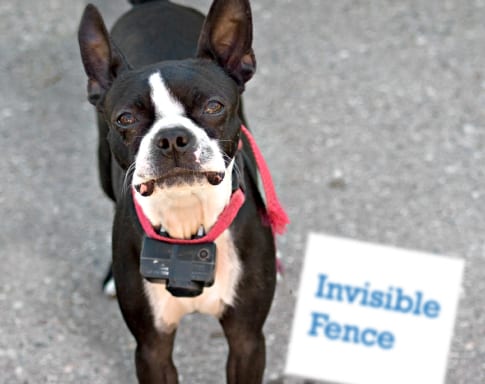Why a Physical Fence Is Better Than an Invisible Fence
The Truth or Consequences of Choosing Between the Two
Many dog owners planning to install a fence for their pet consider an invisible fence as one of the best options on the market. At first, invisible fences seem to be a quick, convenient, and a less-expensive alternative to physical fences. In theory, the warning beep followed by the release of an electric shock through a collar when a dog tries to cross the boundary line should train your pet to stay within the confines of your boundaries. However, whether these expectations are met in practice is questionable. This article looks at the effectiveness of invisible fences and what dangers pet-owners can face when installing invisible fences.
What Is an Invisible Fence?
An invisible fence, also referred to as an electric fence, is a containment system that consists of an underground wire, a transmitter, and a collar creating an electrically charged boundary to keep your pet within your yard’s perimeter. Electric fences are relatively inexpensive and often cost less than the materials and installation required for traditional fencing. In addition, some neighborhoods only allow a few specific types of fences or do not allow physical fences at all, in which case, invisible fences provide greater flexibility for homeowners. Pet owners are happy to know that the strength of the electric shock can often be adjusted to suit the dog’s responsiveness.
Why Invisible Fences Are Not as Effective as Expected
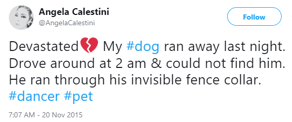
1. Invisible fences do not guarantee containment when the “reward” is great enough.
If your dog loves chasing rabbits, chances are a temporary pain from an electric shock won’t stop your pet from running past the boundaries. Be it chasing other animals, fireworks, or thunder—if the motivation is high enough—your dog can still run through the invisible fence. Once the first attempt is made and your dog learns to deal with the shocks, he will most probably try it again.
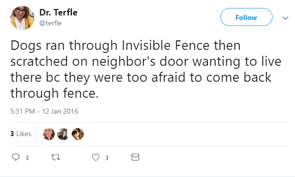
On the other side of that (literally!) being locked out of the yard, your dog may also not want to re-enter because of the fear of getting shocked again, which puts your pet in danger of wandering around and getting lost.
2. Electric shocks are a form of punishment inducing aggression, fear, and anxiety.
Not all the dogs can associate the discomfort of shocks with approaching the boundary line. Experiences of getting shocked can become associated with other random events, such as a person walking by, which may provoke them to become aggressive towards strangers or fear them. If dogs do not understand and correctly associate what is harming them, it causes fear and anxiety, possibly leading to a neurotic behavior.
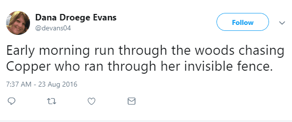
Behavioral problems in dogs correlated with invisible fences have become more common in recent years. Here’s what Jenn Merritt, a certified professional dog trainer for over 15 years, has to say about the issue after her personal and her clients’ negative experience with electric fences:
“As the years have passed and my experience and dog training business have grown, I see more and more clients seeking help with behavior problems directly correlated to installation and use of electric fencing. These issues include housetrained dogs that begin urinating and defecating in the house to avoid the yard, dogs and young puppies that develop frustration, fear and aggression towards people, other dogs, bikes/cars and other things on the outside of the fence, stress related physical issues, and several incidences of dogs getting trapped and repeatedly zapped in the “shock zone” and attacking their owners when they try to move them.”
Doesn’t sound so safe or humane, does it? While not all the dogs develop behavioral problems because of the installation of invisible fences, the risks still exist.
3. Collars can injure pet’s skin.
The problem with collars is in the two prongs that deliver an electric shock when in close contact with your pet’s skin. A loose collar may cause inconsistent results, whereas a collar worn too tightly can cause serious skin issues to the dog. Although manufacturers often recommend removing collars on a regular basis to prevent injuries, collars have been known to cause everything from a simple skin irritation to pressure necrosis in the form of wounds and holes that bear down into the dog’s neck.
4. Invisible fences do not keep the intruders out.
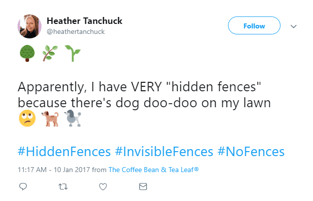
Sure, we are a bit biased at AVO, and we know that in some cases, invisible fences can be effective in keeping your dog within boundaries if the training and subsequent conditions are optimal. However, a vital consideration is that invisible fences do not prevent the intruders from coming into your property. It is particularly important to note in areas with higher risks for dogs—especially smaller ones—where coyotes are common. In these cases, your restricted dog becomes an easy target for the wild animals. Additionally, other aggressive dogs, cats, or even people can freely enter your property, possibly resulting in unanticipated consequences for everyone involved.
Alternatives to Using an Invisible Fence for Dogs
Your dog’s safety and emotional health are important. A physical fence is usually the best option for the safe containment of your dog within your yard’s properties, allowing your pet to explore the outdoors in a consequence-free manner. Physical fences come in a variety of sizes and materials, ranging from smaller enclosures to larger full-yard fences. One of the options to consider is a chain link fence, which is a durable, cost-effective physical fencing solution used for perimeter security and pet safety. If you would like to maintain full visibility of the enclosed area while enjoying a more decorative style, then fences from cedar such as the Sturbridge Spaced Picket are ideal for you. Head to the Privacy section of our product catalog to take a look at fences designed specifically to provide privacy and safety for homeowners and their pets.
If you need help choosing a fence to meet your needs and budget, contact us now for a free consultation. We are happy to help homeowners find the fencing solutions you need to make your property secure, safe, and aesthetic at affordable prices.

